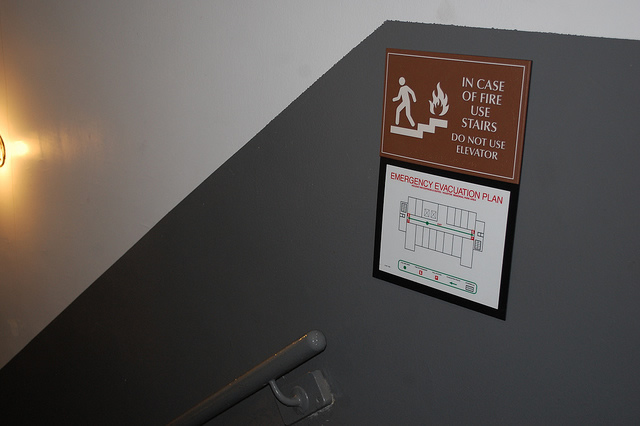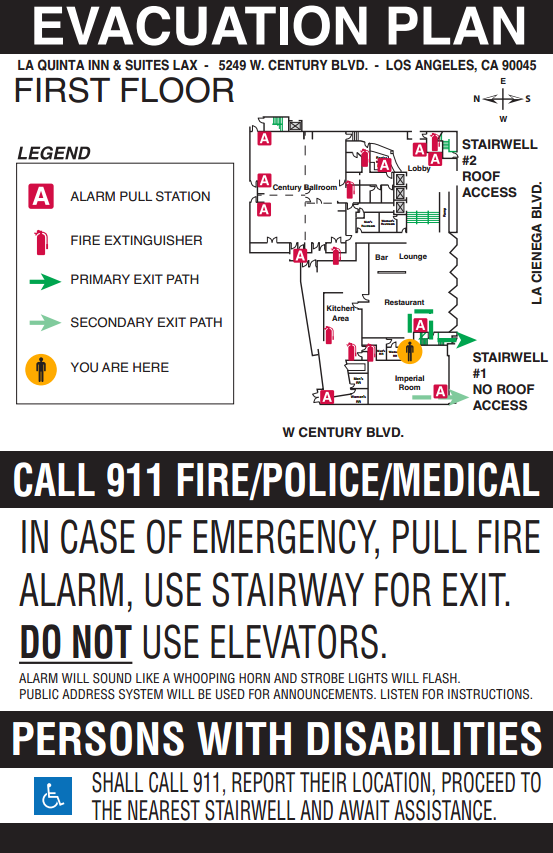What we learned from evacuation sign expert Hank McMahon
Hank McMahon has been making evacuation signs with Intersign Corp. for 35 years. Intersign began making evacuation signs for nursing homes, later expanding into hotels, completing their focus on long-term care and hospitality. They company draws approximately 5,000 evacuation masters a year and prints over 100,000 evacuation plans for hotels and nursing homes nationwide.
Unsurprisingly, after more than three decades in the industry, Hank has amassed a wealth of knowledge on the subject. We talked to him about how evacuation signage has changed over the years and how it hasn’t. Here’s what we learned.
Evacuation signs aren’t the same everywhere
Notably, there are key differences between nursing home and hotel evacuation signs, stemming from the difference in those escapees: one group is ambulatory, while the other is likely not. Hank says:
Nursing homes have a lot more information because they have, in many cases, secure doorways. You don’t want your residents wandering off in the neighborhood. So in a nursing home where you have dementia care or acute care or worries about fraud or theft, you keep the doors locked, and that’s really important. So a lot of times, a lot of the safety plans in a nursing home will include escape plans. For instance, they’ll prioritize who gets out first. You want to get your ambulatory patients out first. It seems like you would go for the wheelchairs and the bedridden first, but you want to get your ambulatory out first and then you go back and get everybody else.
Intersign also sells door hangers to make the evacuation process in nursing homes easier. As staff evacuate patients, they can mark rooms that have already been evacuated.
Hotels, on the other hand, have a different kind of extra information. “In a hotel, on the evacuation plan, you’re going to have the innkeepers laws for that state, which there are essentially a bunch of legal disclaimers for guests: cannot leave valuable things in the room, the maximum room rate, what the hotel can charge, check-in checkout time, and generally a bunch of information that nobody reads.”
Especially not in California
Apparently, California’s evacuation signs go above and beyond the ones in other states. Hank says:
California has really onerous rules about evacuation plans. And basically, some areas on California go along with the Cal OSHA standards. They also have other requirements by state and nationwide, OSHA does, and then California has their own rules. So in many respects – if we were doing a hotel in Santa Monica versus a hotel in Los Angeles, we’d have to call the Fire Marshall in that town and say what are the requirements for evacuation plans, and in many respects, the evacuation plans would have to be oriented vertically, they would have to be tabloid size, they would have to contain specific information that you don’t normally see on an evacuation plan, like the number for the closest fire hall. First responders phone numbers on there. California is always different from everybody else. There are standards are much more stringent and they seem to be more focused on it.

From SmartSign.
But there are must-have pieces of information for every state
To make an evacuation plan, Intersign will start with a building’s floor plan. They then scan and simplify the floor plan to make the map easier to read. “[Escapees] should be able to look at it and know ‘Okay, I need to go this way or this way and not in any other direction.’ So we take out all the extraneous stuff, even the way the doors swing, and just keep it really simple,” Hank says.
Once the unnecessary information is taken away, there are a few elements that the signs need to have. Signs must be easy to read, have a clear “you are here” marker, and be properly oriented to that location. In an emergency, escapees need to spend as little time as possible reading the evacuation map.
Hank recommends that, for optimal fire safety, building owners contact their local Fire Marshall. “The most important fire-safety thing you can do is have a conversation with a Fire Marshall so they have your building layout and your building evacuation plan on file in their office,” he says. “And it would also be good to invite them out because they’re going to come out and inspect your building anyway. Invite out the closest Fire Marshall, closest fire station guy to walk through it, so they’re familiar with your building just in case.”
And this hasn’t changed that much over Hank’s 35 years in the business
Today, all parts of the sign -making process are electronic, but the product that Hank delivers to clients in hospitality and long-term care hasn’t changed much. He says that post 9/11, the National Fire Protection Association standards for stairway and corridor signs have changed, but the standards, need for, evacuation signs stayed mainly the same.











